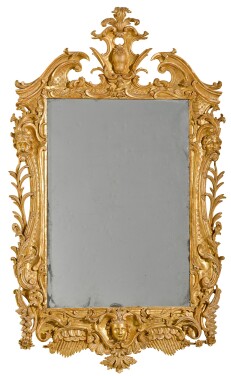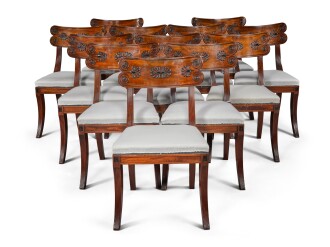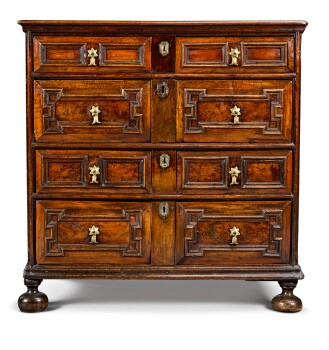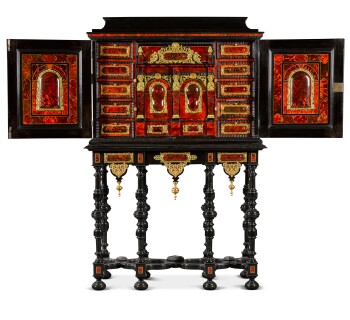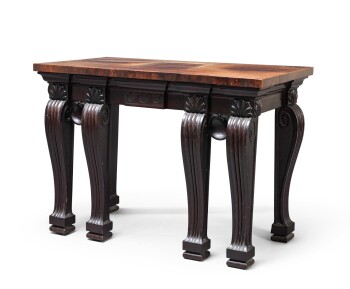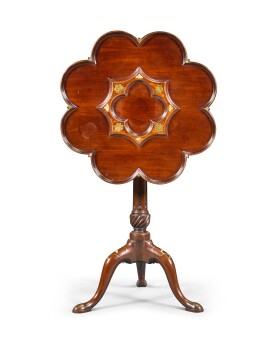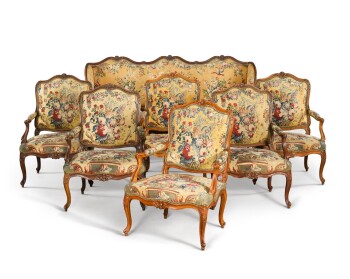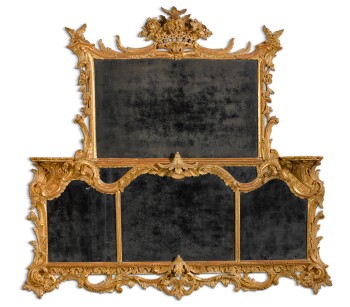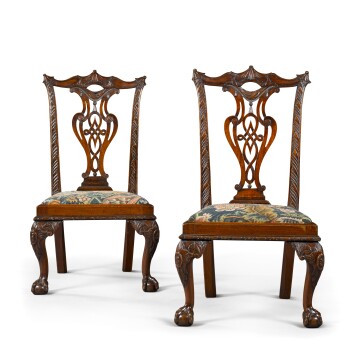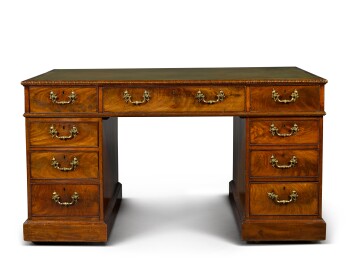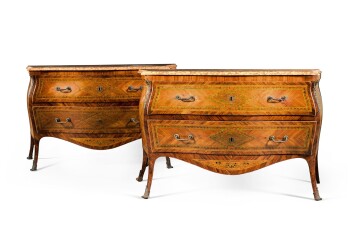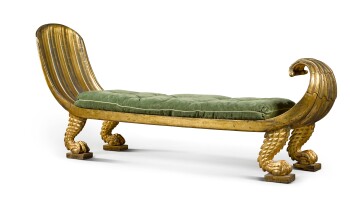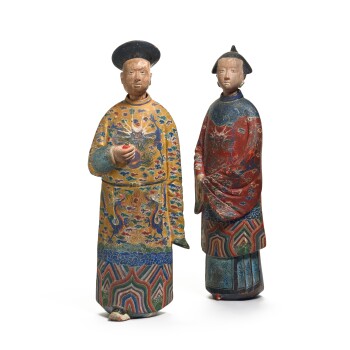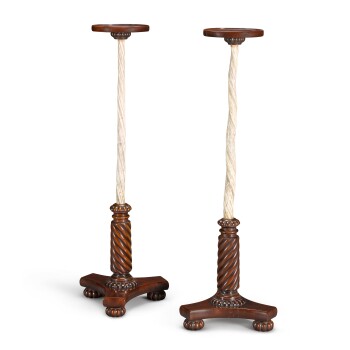O ur bi-annual STYLE: Private Collections sales explore the concept of style throughout the ages and offer a wide selection of English and European furniture pieces, decorative objects, clocks, carpets and tapestries.
The sale this season is mainly led by three private collections, including Property from a Private Collection featuring early oak furniture (lots 21-38), the Distinguished Property from Osterrieth House in Antwerp with an elegant selection of Haute Epoque furniture pieces and tapestries (lots 3-15, 40-56, 78-92, 94); and the Property of a Distinguished Italian Collector (lots 118-140) presenting an important selection of Louis XV and Louis XVI clocks.
Highlights

Centuries of Style
Spanning over 300 years, STYLE presents a fascinating survey of European furniture and decorative art charting the evolution of design from the mid-16th century right the way through to the early 20th century. These centuries marked a period of unparalleled political upheaval and cultural exchange throughout the Western world. Religious schism led to the displacement of courts and craftsmen in the 17th century; the advent of Grand Tours and exciting archaeological discoveries enlightened the designer-architects of the 18th century and the opening of international trade routes – particularly with the East – cultivated the exchange of both aesthetics and materials on a truly global footing.
- 1690
- 1690
- 1730
- 1740
- 1750
- 1750
- 1755
- 1760
- 1790
- 1805
- 1815-20
- 1830
-
 A Charles II oak, walnut and yew veneered chest of drawersEmploying an array of native timbers, the bold geometric design demonstrates the influence of the Low Countries on English design after the restoration of the monarchy in the 17th century.
A Charles II oak, walnut and yew veneered chest of drawersEmploying an array of native timbers, the bold geometric design demonstrates the influence of the Low Countries on English design after the restoration of the monarchy in the 17th century.
Lot 33 -
 A Flemish Baroque gilt-metal mounted ebony, rosewood, tortoiseshell and inlaid cabinet-on-stand, probably AntwerpThis striking piece displays the many costly exotic materials which the Flemish cabinet makers had access to through newly established trade routes to the West Indies, South and South-East Asia and beyond.
A Flemish Baroque gilt-metal mounted ebony, rosewood, tortoiseshell and inlaid cabinet-on-stand, probably AntwerpThis striking piece displays the many costly exotic materials which the Flemish cabinet makers had access to through newly established trade routes to the West Indies, South and South-East Asia and beyond.
Lot 41 -
 A George II carved mahogany side tableThis table epitomises the bold, architectural style popularised by William Kent (1685-1748). Heavily influenced by the designs of architects Andrea Palladio (1508-1580) and Inigo Jones (1573-1652), Kent and his circle of patrons developed a style steeped in classical language fit for the stately homes of the early Georgian era.
A George II carved mahogany side tableThis table epitomises the bold, architectural style popularised by William Kent (1685-1748). Heavily influenced by the designs of architects Andrea Palladio (1508-1580) and Inigo Jones (1573-1652), Kent and his circle of patrons developed a style steeped in classical language fit for the stately homes of the early Georgian era.
Lot 64 -
 A George III brass and mother-of-pearl inlaid mahogany supper tableThroughout the 18th century, England - and London in particular - benefited from the influx of émigré craftsmen who brought with them new techniques. German-born cabinet-maker Johann Frederick Hintz, (d.1776) is a case in point, whose distinctive brass and mother-of-pearl inlay technique was applied to English forms such as this quintessentially Georgian tilt-top supper table.
A George III brass and mother-of-pearl inlaid mahogany supper tableThroughout the 18th century, England - and London in particular - benefited from the influx of émigré craftsmen who brought with them new techniques. German-born cabinet-maker Johann Frederick Hintz, (d.1776) is a case in point, whose distinctive brass and mother-of-pearl inlay technique was applied to English forms such as this quintessentially Georgian tilt-top supper table.
Lot 66 -
 A Louis XV suite of carved beechwood seat furniture by Michel CressonWith the advent of the rococo style which became fashionable in Paris from the 1730s, the Rococo was expressed in two ways in chair-making: the emphasis on fluid mouldings and high relief, and curves. The various parts of the chair were no longer separate but flowed into one another, the armrest support was joined to the seat rail by a wide fluid moulding.
A Louis XV suite of carved beechwood seat furniture by Michel CressonWith the advent of the rococo style which became fashionable in Paris from the 1730s, the Rococo was expressed in two ways in chair-making: the emphasis on fluid mouldings and high relief, and curves. The various parts of the chair were no longer separate but flowed into one another, the armrest support was joined to the seat rail by a wide fluid moulding.
Lot 78 -
 A George II carved giltwood overmantel mirrorThe impact of Parisian design on the rest of Europe cannot be overstated in the 18th century. This English overmantel – conceived to hang above a chimneypiece - is a testament to that, incorporating C-scrolls and other ubiquitous rococo motifs and mounted with bracket supports for displaying blue and white Chinese porcelain.
A George II carved giltwood overmantel mirrorThe impact of Parisian design on the rest of Europe cannot be overstated in the 18th century. This English overmantel – conceived to hang above a chimneypiece - is a testament to that, incorporating C-scrolls and other ubiquitous rococo motifs and mounted with bracket supports for displaying blue and white Chinese porcelain.
Lot 68 -
 A pair of George II carved mahogany 'child’s' chairThomas Chippendale’s name is synonymous with the best of English craftsmanship. Although these remarkable chairs are not by the great man, the influence of his famous pattern book The Gentleman and Cabinet-Maker's Director (1754) is clear as he popularized the confluence of styles seen on the wonderfully drawn back splats.
A pair of George II carved mahogany 'child’s' chairThomas Chippendale’s name is synonymous with the best of English craftsmanship. Although these remarkable chairs are not by the great man, the influence of his famous pattern book The Gentleman and Cabinet-Maker's Director (1754) is clear as he popularized the confluence of styles seen on the wonderfully drawn back splats.
Lot 71 -
 A George III mahogany pedestal deskThe Georgian pedestal desk is a timeless piece of design whose rectilinear form is comprised of three individual sections and was an essential item of furniture in a gentleman’s library.
A George III mahogany pedestal deskThe Georgian pedestal desk is a timeless piece of design whose rectilinear form is comprised of three individual sections and was an essential item of furniture in a gentleman’s library.
Lot 150 -
 A pair of South Italian gilt-bronze mounted rosewood and kingwood marquetry commodes, NaplesThese bombé commodes, which mix serpentine lines with geometric inlay, are a brilliant example of Neapolitan cabinet-making in the third quarter of the 18th century and reflecting the transition from the rococo to the neoclassical style.
A pair of South Italian gilt-bronze mounted rosewood and kingwood marquetry commodes, NaplesThese bombé commodes, which mix serpentine lines with geometric inlay, are a brilliant example of Neapolitan cabinet-making in the third quarter of the 18th century and reflecting the transition from the rococo to the neoclassical style.
Lot 120 -
 Regency giltwood and cane daybedThis fantastical daybed is fashioned after an Egyptian river boat resting on crocodile feet and reflects the influence of ancient Egyptian motifs in Regency England inspired by the archaeological discoveries made during Napoleon's military campaigns of 1798.
Regency giltwood and cane daybedThis fantastical daybed is fashioned after an Egyptian river boat resting on crocodile feet and reflects the influence of ancient Egyptian motifs in Regency England inspired by the archaeological discoveries made during Napoleon's military campaigns of 1798.
Lot 163 -
 A pair of Chinese Export painted clay 'nodding head' figuresGeorge IV, when Prince of Wales, acquired at least eight of these figures which were displayed in the Gallery at The Pavilion. They possibly originate from South China, within reach of the port of Guangzhou, one of the great centres for material exported to Europe.
A pair of Chinese Export painted clay 'nodding head' figuresGeorge IV, when Prince of Wales, acquired at least eight of these figures which were displayed in the Gallery at The Pavilion. They possibly originate from South China, within reach of the port of Guangzhou, one of the great centres for material exported to Europe.
Lot 102 -
 A pair William IV narwhal tusk and mahogany torchèresNarwhal tusks were often part of the European kuntskammer created by discerning collectors of the Renaissance. Thought to possess magical properties, including the power to purify poisoned water, it was believed by some they were the mythical horns from unicorns. Interest in natural history exploded in the 19th century with the collection of taxidermy and other specimens as evidenced by these highly unusual torchères.
A pair William IV narwhal tusk and mahogany torchèresNarwhal tusks were often part of the European kuntskammer created by discerning collectors of the Renaissance. Thought to possess magical properties, including the power to purify poisoned water, it was believed by some they were the mythical horns from unicorns. Interest in natural history exploded in the 19th century with the collection of taxidermy and other specimens as evidenced by these highly unusual torchères.
Lot 160
Threads of Splendour
Dating from the 16th through to the 19th century, the exciting group of tapestries in this sale represent various European weaving centres and depict the most important themes including, mythological, biblical and classical subjects. These tapestries ranging from a small to a large scale reflect the importance of their subjects, their scale and effect on the viewer, including those which are fragments of once larger panels. There are the thought provoking allegorical (Virtus, Illustrious women of antiquity, and the Monkey Hunt), biblical (Story of David and Susanna and the elders), classical (Triumph and Amadis and Oriana), and romance (Literary pastoral, l’Astree) subjects; all encouraging us to attain the highest standards and consider our actions and thoughts, and others which are confirmation of the advantages of life in harmony with nature (Hunting Tapestry, Fish Quay , Genre with boys climbing tree and a floral cantonniere).
The Value of Time
The horological highlights of this sale comprise a very fine group of clocks from the collection of a distinguished Italian collector. Amassed over many years, they are primarily French and from the second half of the 18th century. The collector’s fascination with horological innovation and accuracy of timekeeping is well illustrated by the inclusion of two fine Louis XVI skeleton clocks, both with remontoires, the very rare Italian weight-driven skeleton clock with constant force escapement by Alberti of Milan and a 20th century 8-day mantel chronometer by Thomas Mercer. The collection also includes highly attractive mantel and cartel clocks and a German renaissance automaton clock from circa 1600.
From other consignors, highlights include a newly discovered 30-hour wall clock by the most important of English makers, Thomas Tompion, which becomes only the third such clock by this maker to be recorded.
The Age of Oak: ‘Joined’ Up!
A small private collection of oak (lots 21-38) presents us with a discerning survey of 17th century British craftsmanship. Pieces produced by the master joiner before the advent of the 18th century master ‘cabinetmaker’, the import of tropical hardwoods and the publication of fashionable plate books of ornate design by Chippendale et al. There is sense of ‘truth to material’ through simplicity of design and an appreciation of homegrown materials in early British vernacular furniture. What better reflection of this ideal than the functionality and form of the joined stool? Visibly engineered with pegged seats and stretchers. Simple and compact. These robust little objects are not just seats but tables, steps and trestle supports a multifunctional object which can be easily tucked away and is almost modular. Seat furniture for the everyman but through the turners lathe and chisel, we have a restrained ornamental flourish in legs and carved friezes. These stools, two of which are presented here, encapsulate not only the 16th and 17th century ‘Age of Oak’ but are fundamentally a full expression of British craftsmanship.





